Impact of Macro Environment on Organization and Strategies
VerifiedAdded on 2023/01/19
|15
|4959
|29
AI Summary
This report addresses the impact of macro environment on organization and strategies, analysis of internal environment, Porter fiver force model and Ansoff matrix and strategic marketing plan.
Contribute Materials
Your contribution can guide someone’s learning journey. Share your
documents today.
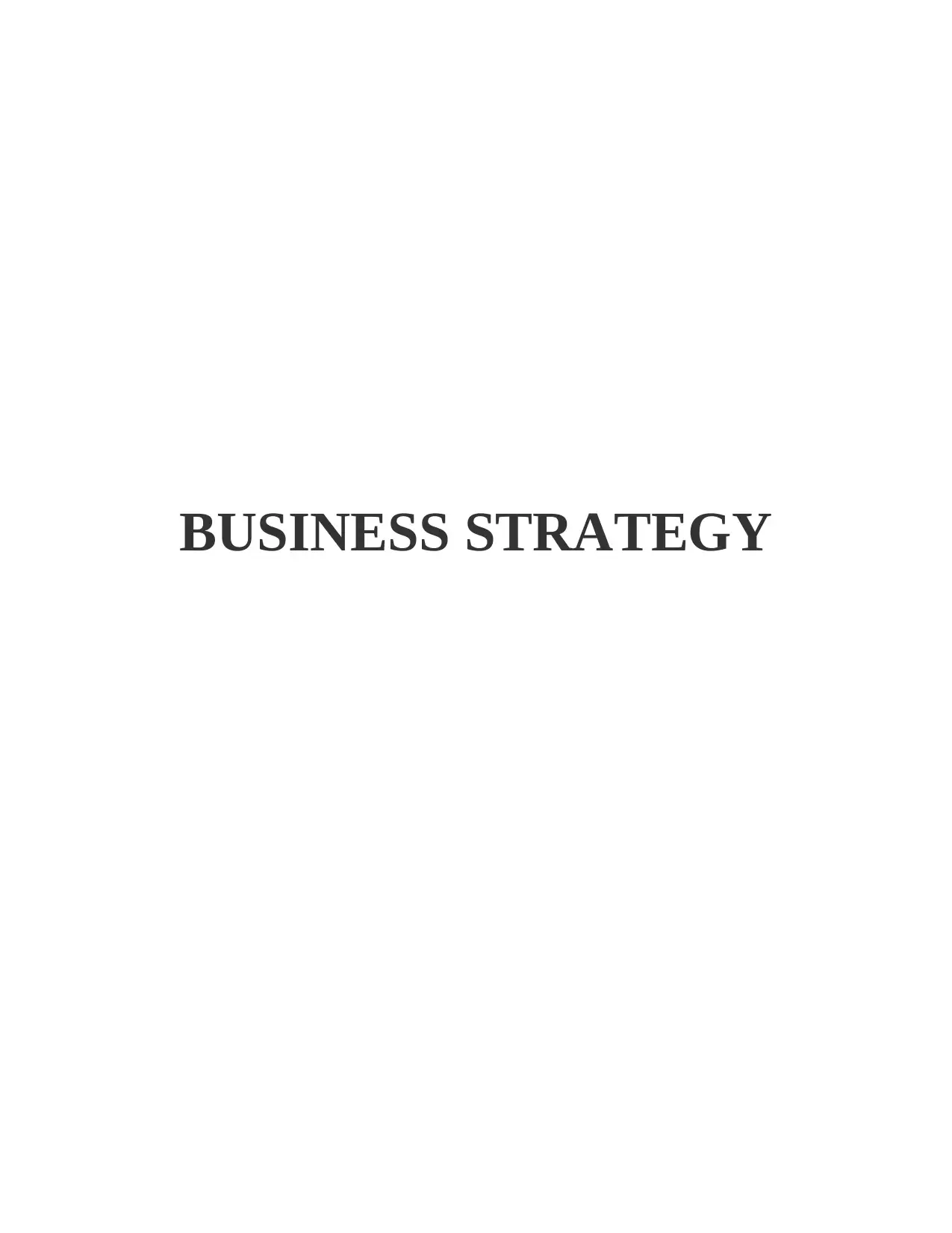
BUSINESS STRATEGY
Secure Best Marks with AI Grader
Need help grading? Try our AI Grader for instant feedback on your assignments.
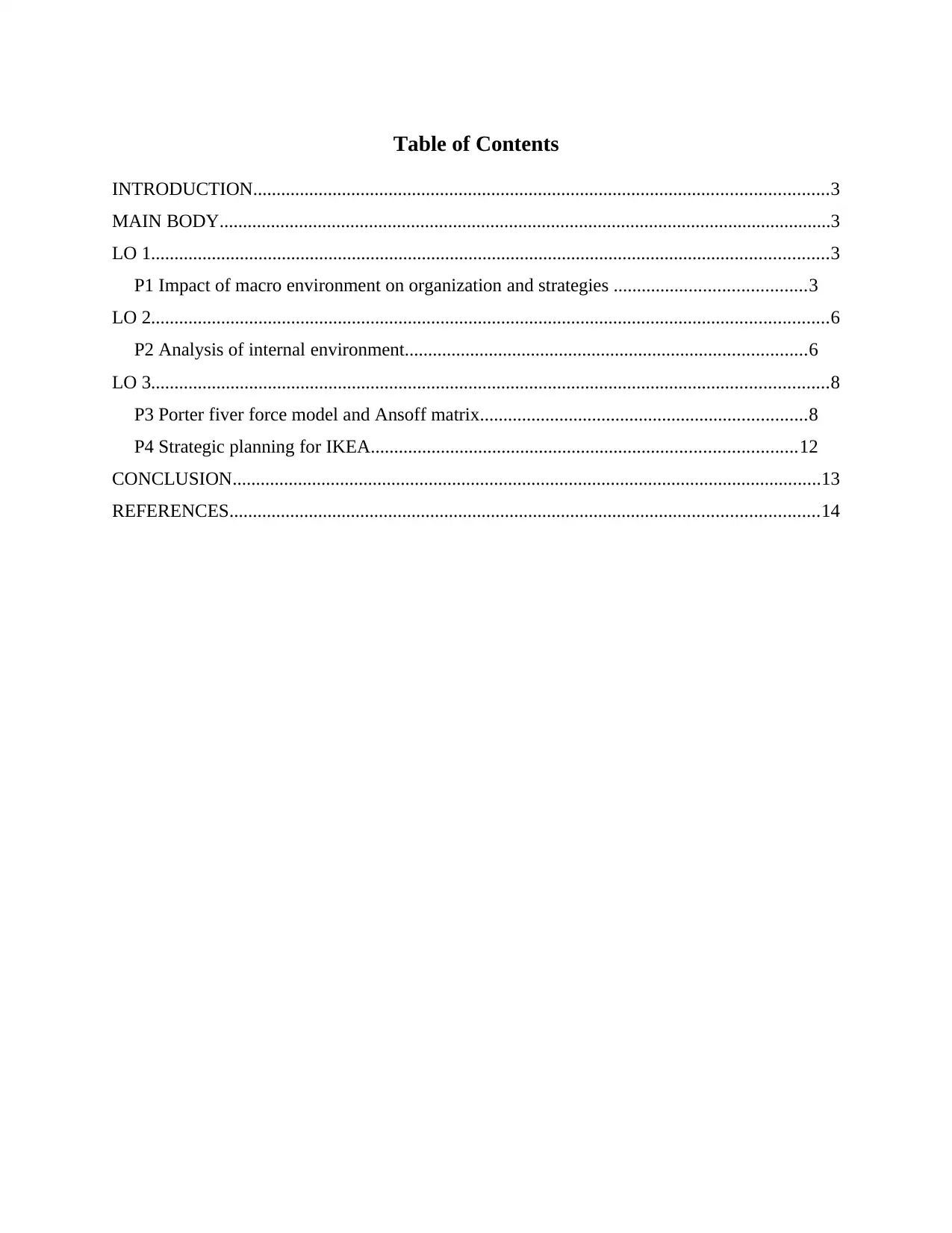
Table of Contents
INTRODUCTION...........................................................................................................................3
MAIN BODY...................................................................................................................................3
LO 1.................................................................................................................................................3
P1 Impact of macro environment on organization and strategies .........................................3
LO 2.................................................................................................................................................6
P2 Analysis of internal environment......................................................................................6
LO 3.................................................................................................................................................8
P3 Porter fiver force model and Ansoff matrix......................................................................8
P4 Strategic planning for IKEA...........................................................................................12
CONCLUSION..............................................................................................................................13
REFERENCES..............................................................................................................................14
INTRODUCTION...........................................................................................................................3
MAIN BODY...................................................................................................................................3
LO 1.................................................................................................................................................3
P1 Impact of macro environment on organization and strategies .........................................3
LO 2.................................................................................................................................................6
P2 Analysis of internal environment......................................................................................6
LO 3.................................................................................................................................................8
P3 Porter fiver force model and Ansoff matrix......................................................................8
P4 Strategic planning for IKEA...........................................................................................12
CONCLUSION..............................................................................................................................13
REFERENCES..............................................................................................................................14
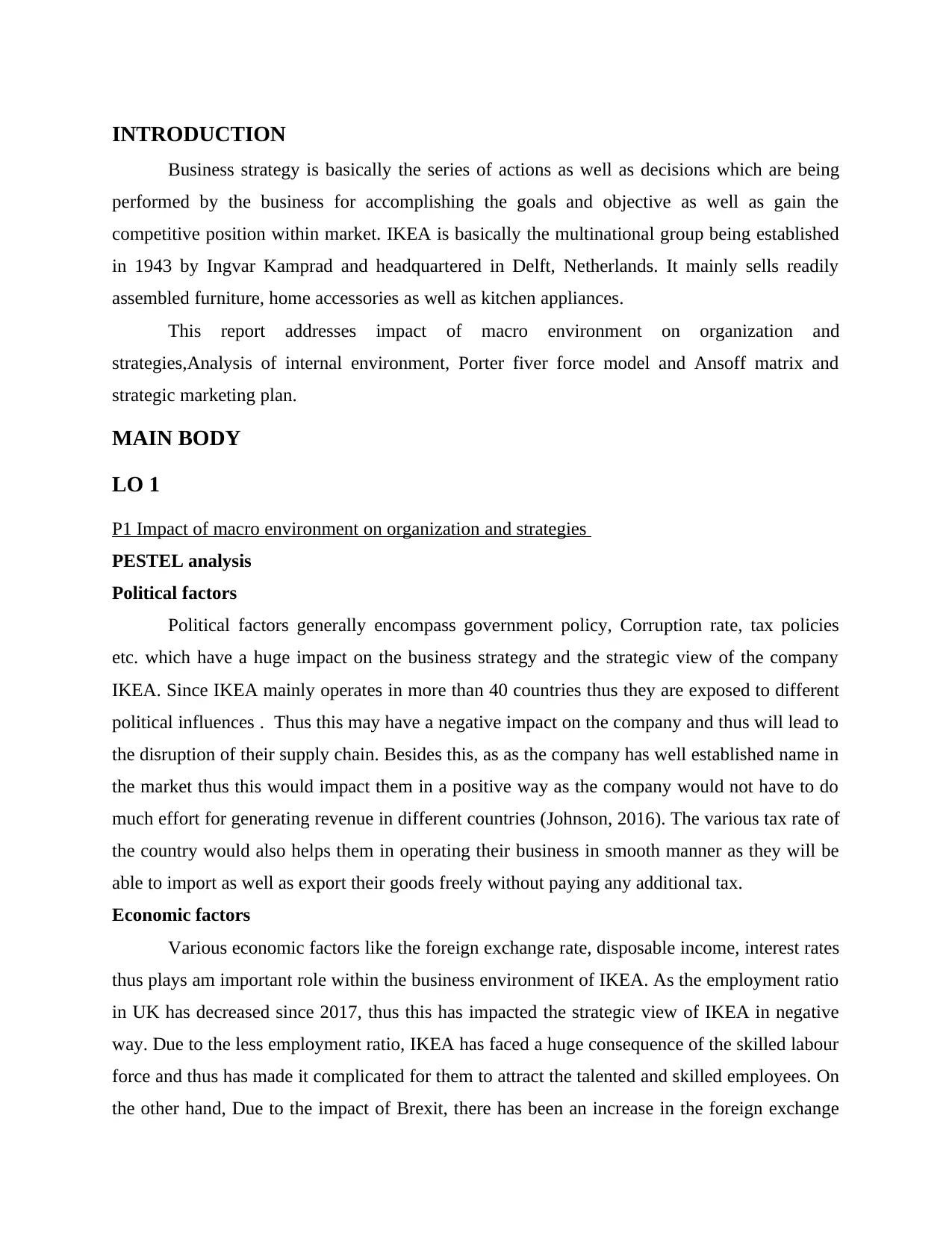
INTRODUCTION
Business strategy is basically the series of actions as well as decisions which are being
performed by the business for accomplishing the goals and objective as well as gain the
competitive position within market. IKEA is basically the multinational group being established
in 1943 by Ingvar Kamprad and headquartered in Delft, Netherlands. It mainly sells readily
assembled furniture, home accessories as well as kitchen appliances.
This report addresses impact of macro environment on organization and
strategies,Analysis of internal environment, Porter fiver force model and Ansoff matrix and
strategic marketing plan.
MAIN BODY
LO 1
P1 Impact of macro environment on organization and strategies
PESTEL analysis
Political factors
Political factors generally encompass government policy, Corruption rate, tax policies
etc. which have a huge impact on the business strategy and the strategic view of the company
IKEA. Since IKEA mainly operates in more than 40 countries thus they are exposed to different
political influences . Thus this may have a negative impact on the company and thus will lead to
the disruption of their supply chain. Besides this, as as the company has well established name in
the market thus this would impact them in a positive way as the company would not have to do
much effort for generating revenue in different countries (Johnson, 2016). The various tax rate of
the country would also helps them in operating their business in smooth manner as they will be
able to import as well as export their goods freely without paying any additional tax.
Economic factors
Various economic factors like the foreign exchange rate, disposable income, interest rates
thus plays am important role within the business environment of IKEA. As the employment ratio
in UK has decreased since 2017, thus this has impacted the strategic view of IKEA in negative
way. Due to the less employment ratio, IKEA has faced a huge consequence of the skilled labour
force and thus has made it complicated for them to attract the talented and skilled employees. On
the other hand, Due to the impact of Brexit, there has been an increase in the foreign exchange
Business strategy is basically the series of actions as well as decisions which are being
performed by the business for accomplishing the goals and objective as well as gain the
competitive position within market. IKEA is basically the multinational group being established
in 1943 by Ingvar Kamprad and headquartered in Delft, Netherlands. It mainly sells readily
assembled furniture, home accessories as well as kitchen appliances.
This report addresses impact of macro environment on organization and
strategies,Analysis of internal environment, Porter fiver force model and Ansoff matrix and
strategic marketing plan.
MAIN BODY
LO 1
P1 Impact of macro environment on organization and strategies
PESTEL analysis
Political factors
Political factors generally encompass government policy, Corruption rate, tax policies
etc. which have a huge impact on the business strategy and the strategic view of the company
IKEA. Since IKEA mainly operates in more than 40 countries thus they are exposed to different
political influences . Thus this may have a negative impact on the company and thus will lead to
the disruption of their supply chain. Besides this, as as the company has well established name in
the market thus this would impact them in a positive way as the company would not have to do
much effort for generating revenue in different countries (Johnson, 2016). The various tax rate of
the country would also helps them in operating their business in smooth manner as they will be
able to import as well as export their goods freely without paying any additional tax.
Economic factors
Various economic factors like the foreign exchange rate, disposable income, interest rates
thus plays am important role within the business environment of IKEA. As the employment ratio
in UK has decreased since 2017, thus this has impacted the strategic view of IKEA in negative
way. Due to the less employment ratio, IKEA has faced a huge consequence of the skilled labour
force and thus has made it complicated for them to attract the talented and skilled employees. On
the other hand, Due to the impact of Brexit, there has been an increase in the foreign exchange
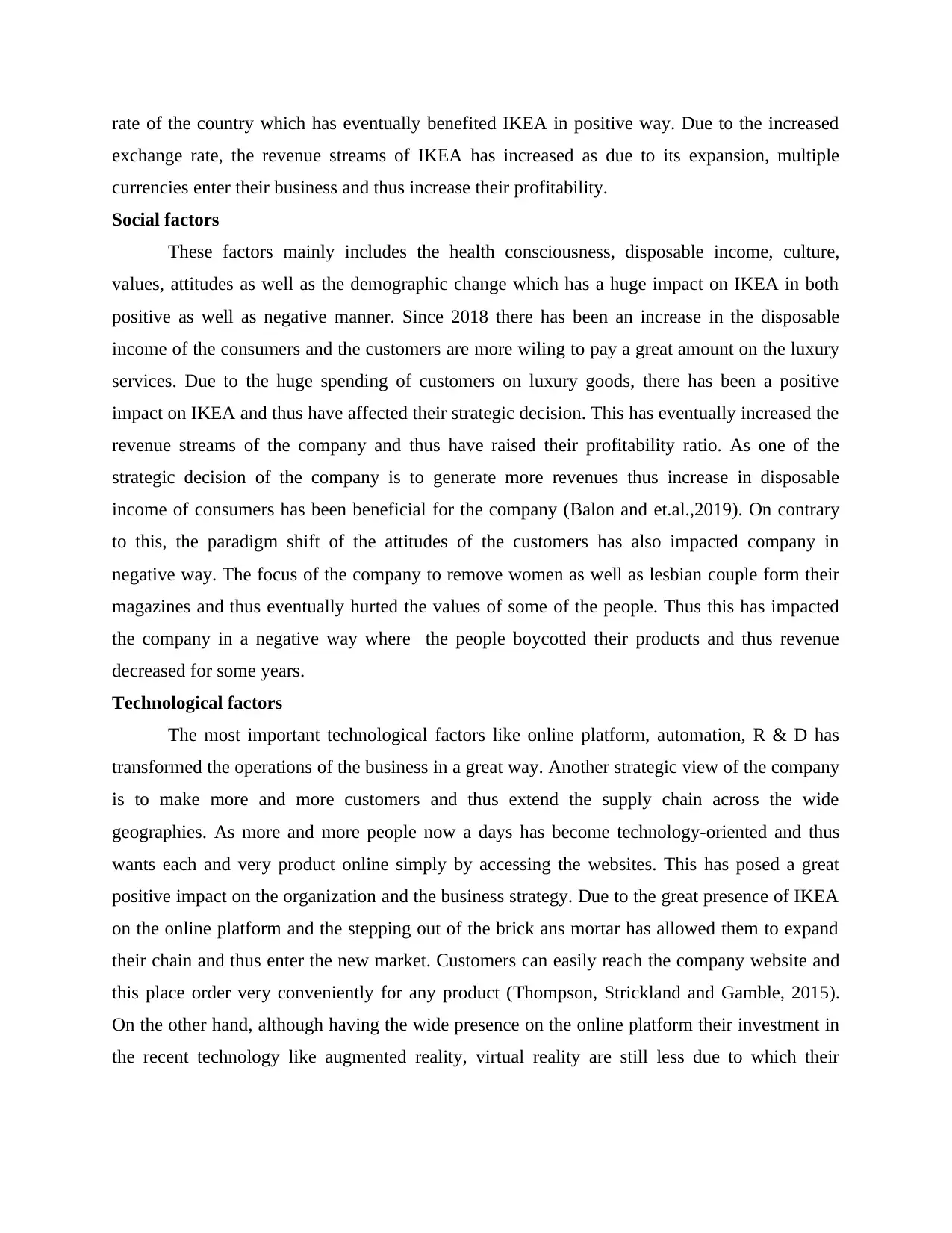
rate of the country which has eventually benefited IKEA in positive way. Due to the increased
exchange rate, the revenue streams of IKEA has increased as due to its expansion, multiple
currencies enter their business and thus increase their profitability.
Social factors
These factors mainly includes the health consciousness, disposable income, culture,
values, attitudes as well as the demographic change which has a huge impact on IKEA in both
positive as well as negative manner. Since 2018 there has been an increase in the disposable
income of the consumers and the customers are more wiling to pay a great amount on the luxury
services. Due to the huge spending of customers on luxury goods, there has been a positive
impact on IKEA and thus have affected their strategic decision. This has eventually increased the
revenue streams of the company and thus have raised their profitability ratio. As one of the
strategic decision of the company is to generate more revenues thus increase in disposable
income of consumers has been beneficial for the company (Balon and et.al.,2019). On contrary
to this, the paradigm shift of the attitudes of the customers has also impacted company in
negative way. The focus of the company to remove women as well as lesbian couple form their
magazines and thus eventually hurted the values of some of the people. Thus this has impacted
the company in a negative way where the people boycotted their products and thus revenue
decreased for some years.
Technological factors
The most important technological factors like online platform, automation, R & D has
transformed the operations of the business in a great way. Another strategic view of the company
is to make more and more customers and thus extend the supply chain across the wide
geographies. As more and more people now a days has become technology-oriented and thus
wants each and very product online simply by accessing the websites. This has posed a great
positive impact on the organization and the business strategy. Due to the great presence of IKEA
on the online platform and the stepping out of the brick ans mortar has allowed them to expand
their chain and thus enter the new market. Customers can easily reach the company website and
this place order very conveniently for any product (Thompson, Strickland and Gamble, 2015).
On the other hand, although having the wide presence on the online platform their investment in
the recent technology like augmented reality, virtual reality are still less due to which their
exchange rate, the revenue streams of IKEA has increased as due to its expansion, multiple
currencies enter their business and thus increase their profitability.
Social factors
These factors mainly includes the health consciousness, disposable income, culture,
values, attitudes as well as the demographic change which has a huge impact on IKEA in both
positive as well as negative manner. Since 2018 there has been an increase in the disposable
income of the consumers and the customers are more wiling to pay a great amount on the luxury
services. Due to the huge spending of customers on luxury goods, there has been a positive
impact on IKEA and thus have affected their strategic decision. This has eventually increased the
revenue streams of the company and thus have raised their profitability ratio. As one of the
strategic decision of the company is to generate more revenues thus increase in disposable
income of consumers has been beneficial for the company (Balon and et.al.,2019). On contrary
to this, the paradigm shift of the attitudes of the customers has also impacted company in
negative way. The focus of the company to remove women as well as lesbian couple form their
magazines and thus eventually hurted the values of some of the people. Thus this has impacted
the company in a negative way where the people boycotted their products and thus revenue
decreased for some years.
Technological factors
The most important technological factors like online platform, automation, R & D has
transformed the operations of the business in a great way. Another strategic view of the company
is to make more and more customers and thus extend the supply chain across the wide
geographies. As more and more people now a days has become technology-oriented and thus
wants each and very product online simply by accessing the websites. This has posed a great
positive impact on the organization and the business strategy. Due to the great presence of IKEA
on the online platform and the stepping out of the brick ans mortar has allowed them to expand
their chain and thus enter the new market. Customers can easily reach the company website and
this place order very conveniently for any product (Thompson, Strickland and Gamble, 2015).
On the other hand, although having the wide presence on the online platform their investment in
the recent technology like augmented reality, virtual reality are still less due to which their
Secure Best Marks with AI Grader
Need help grading? Try our AI Grader for instant feedback on your assignments.
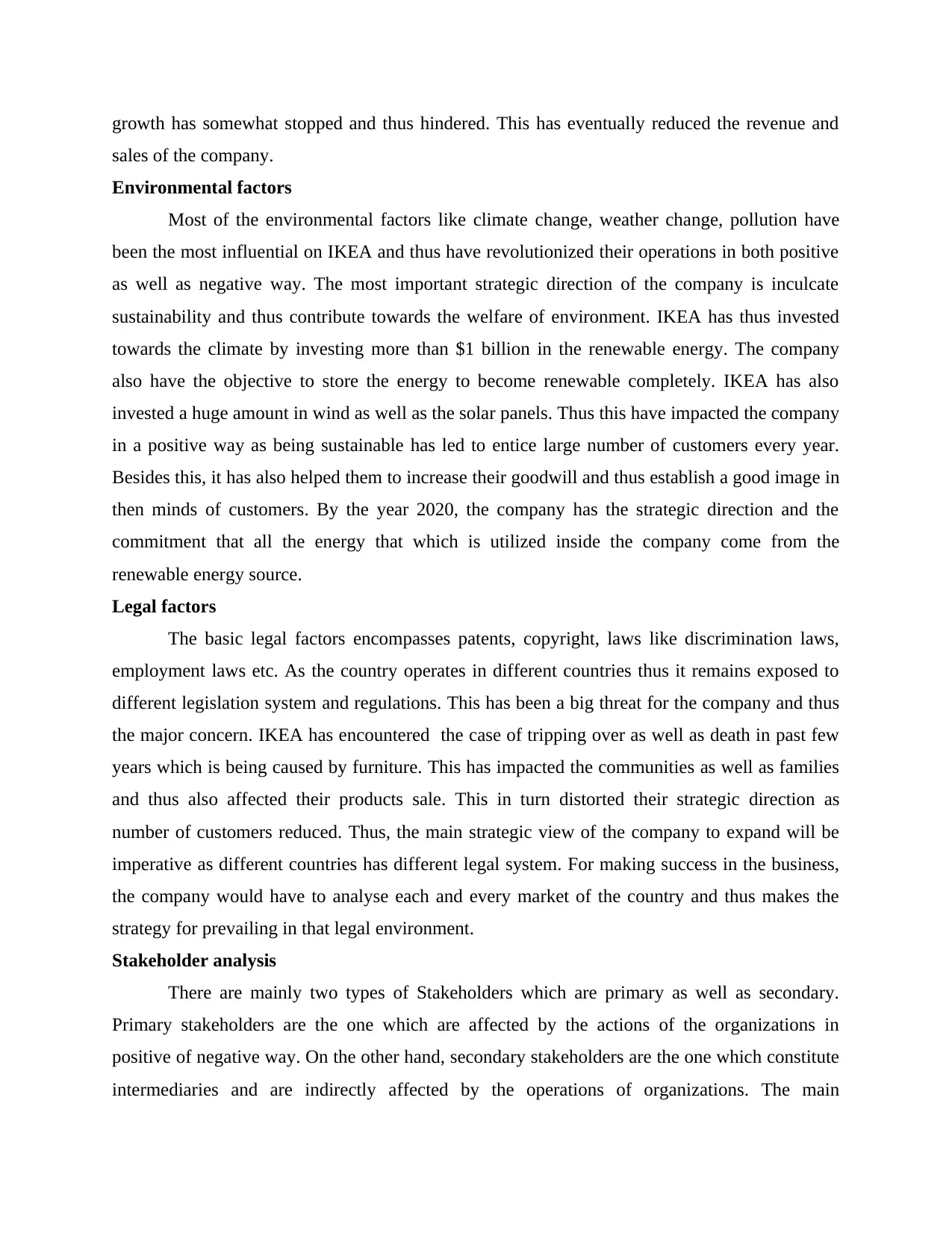
growth has somewhat stopped and thus hindered. This has eventually reduced the revenue and
sales of the company.
Environmental factors
Most of the environmental factors like climate change, weather change, pollution have
been the most influential on IKEA and thus have revolutionized their operations in both positive
as well as negative way. The most important strategic direction of the company is inculcate
sustainability and thus contribute towards the welfare of environment. IKEA has thus invested
towards the climate by investing more than $1 billion in the renewable energy. The company
also have the objective to store the energy to become renewable completely. IKEA has also
invested a huge amount in wind as well as the solar panels. Thus this have impacted the company
in a positive way as being sustainable has led to entice large number of customers every year.
Besides this, it has also helped them to increase their goodwill and thus establish a good image in
then minds of customers. By the year 2020, the company has the strategic direction and the
commitment that all the energy that which is utilized inside the company come from the
renewable energy source.
Legal factors
The basic legal factors encompasses patents, copyright, laws like discrimination laws,
employment laws etc. As the country operates in different countries thus it remains exposed to
different legislation system and regulations. This has been a big threat for the company and thus
the major concern. IKEA has encountered the case of tripping over as well as death in past few
years which is being caused by furniture. This has impacted the communities as well as families
and thus also affected their products sale. This in turn distorted their strategic direction as
number of customers reduced. Thus, the main strategic view of the company to expand will be
imperative as different countries has different legal system. For making success in the business,
the company would have to analyse each and every market of the country and thus makes the
strategy for prevailing in that legal environment.
Stakeholder analysis
There are mainly two types of Stakeholders which are primary as well as secondary.
Primary stakeholders are the one which are affected by the actions of the organizations in
positive of negative way. On the other hand, secondary stakeholders are the one which constitute
intermediaries and are indirectly affected by the operations of organizations. The main
sales of the company.
Environmental factors
Most of the environmental factors like climate change, weather change, pollution have
been the most influential on IKEA and thus have revolutionized their operations in both positive
as well as negative way. The most important strategic direction of the company is inculcate
sustainability and thus contribute towards the welfare of environment. IKEA has thus invested
towards the climate by investing more than $1 billion in the renewable energy. The company
also have the objective to store the energy to become renewable completely. IKEA has also
invested a huge amount in wind as well as the solar panels. Thus this have impacted the company
in a positive way as being sustainable has led to entice large number of customers every year.
Besides this, it has also helped them to increase their goodwill and thus establish a good image in
then minds of customers. By the year 2020, the company has the strategic direction and the
commitment that all the energy that which is utilized inside the company come from the
renewable energy source.
Legal factors
The basic legal factors encompasses patents, copyright, laws like discrimination laws,
employment laws etc. As the country operates in different countries thus it remains exposed to
different legislation system and regulations. This has been a big threat for the company and thus
the major concern. IKEA has encountered the case of tripping over as well as death in past few
years which is being caused by furniture. This has impacted the communities as well as families
and thus also affected their products sale. This in turn distorted their strategic direction as
number of customers reduced. Thus, the main strategic view of the company to expand will be
imperative as different countries has different legal system. For making success in the business,
the company would have to analyse each and every market of the country and thus makes the
strategy for prevailing in that legal environment.
Stakeholder analysis
There are mainly two types of Stakeholders which are primary as well as secondary.
Primary stakeholders are the one which are affected by the actions of the organizations in
positive of negative way. On the other hand, secondary stakeholders are the one which constitute
intermediaries and are indirectly affected by the operations of organizations. The main
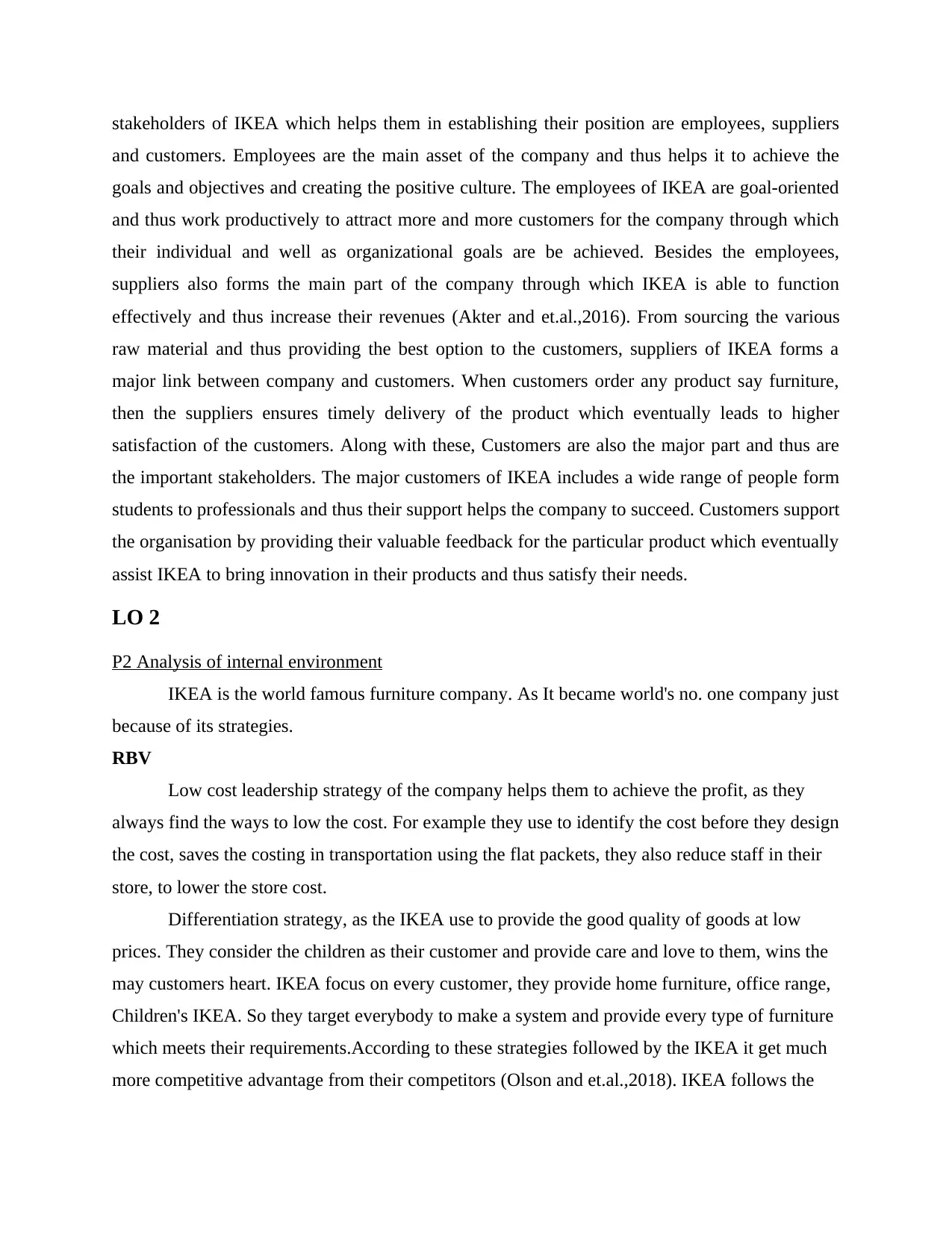
stakeholders of IKEA which helps them in establishing their position are employees, suppliers
and customers. Employees are the main asset of the company and thus helps it to achieve the
goals and objectives and creating the positive culture. The employees of IKEA are goal-oriented
and thus work productively to attract more and more customers for the company through which
their individual and well as organizational goals are be achieved. Besides the employees,
suppliers also forms the main part of the company through which IKEA is able to function
effectively and thus increase their revenues (Akter and et.al.,2016). From sourcing the various
raw material and thus providing the best option to the customers, suppliers of IKEA forms a
major link between company and customers. When customers order any product say furniture,
then the suppliers ensures timely delivery of the product which eventually leads to higher
satisfaction of the customers. Along with these, Customers are also the major part and thus are
the important stakeholders. The major customers of IKEA includes a wide range of people form
students to professionals and thus their support helps the company to succeed. Customers support
the organisation by providing their valuable feedback for the particular product which eventually
assist IKEA to bring innovation in their products and thus satisfy their needs.
LO 2
P2 Analysis of internal environment
IKEA is the world famous furniture company. As It became world's no. one company just
because of its strategies.
RBV
Low cost leadership strategy of the company helps them to achieve the profit, as they
always find the ways to low the cost. For example they use to identify the cost before they design
the cost, saves the costing in transportation using the flat packets, they also reduce staff in their
store, to lower the store cost.
Differentiation strategy, as the IKEA use to provide the good quality of goods at low
prices. They consider the children as their customer and provide care and love to them, wins the
may customers heart. IKEA focus on every customer, they provide home furniture, office range,
Children's IKEA. So they target everybody to make a system and provide every type of furniture
which meets their requirements.According to these strategies followed by the IKEA it get much
more competitive advantage from their competitors (Olson and et.al.,2018). IKEA follows the
and customers. Employees are the main asset of the company and thus helps it to achieve the
goals and objectives and creating the positive culture. The employees of IKEA are goal-oriented
and thus work productively to attract more and more customers for the company through which
their individual and well as organizational goals are be achieved. Besides the employees,
suppliers also forms the main part of the company through which IKEA is able to function
effectively and thus increase their revenues (Akter and et.al.,2016). From sourcing the various
raw material and thus providing the best option to the customers, suppliers of IKEA forms a
major link between company and customers. When customers order any product say furniture,
then the suppliers ensures timely delivery of the product which eventually leads to higher
satisfaction of the customers. Along with these, Customers are also the major part and thus are
the important stakeholders. The major customers of IKEA includes a wide range of people form
students to professionals and thus their support helps the company to succeed. Customers support
the organisation by providing their valuable feedback for the particular product which eventually
assist IKEA to bring innovation in their products and thus satisfy their needs.
LO 2
P2 Analysis of internal environment
IKEA is the world famous furniture company. As It became world's no. one company just
because of its strategies.
RBV
Low cost leadership strategy of the company helps them to achieve the profit, as they
always find the ways to low the cost. For example they use to identify the cost before they design
the cost, saves the costing in transportation using the flat packets, they also reduce staff in their
store, to lower the store cost.
Differentiation strategy, as the IKEA use to provide the good quality of goods at low
prices. They consider the children as their customer and provide care and love to them, wins the
may customers heart. IKEA focus on every customer, they provide home furniture, office range,
Children's IKEA. So they target everybody to make a system and provide every type of furniture
which meets their requirements.According to these strategies followed by the IKEA it get much
more competitive advantage from their competitors (Olson and et.al.,2018). IKEA follows the
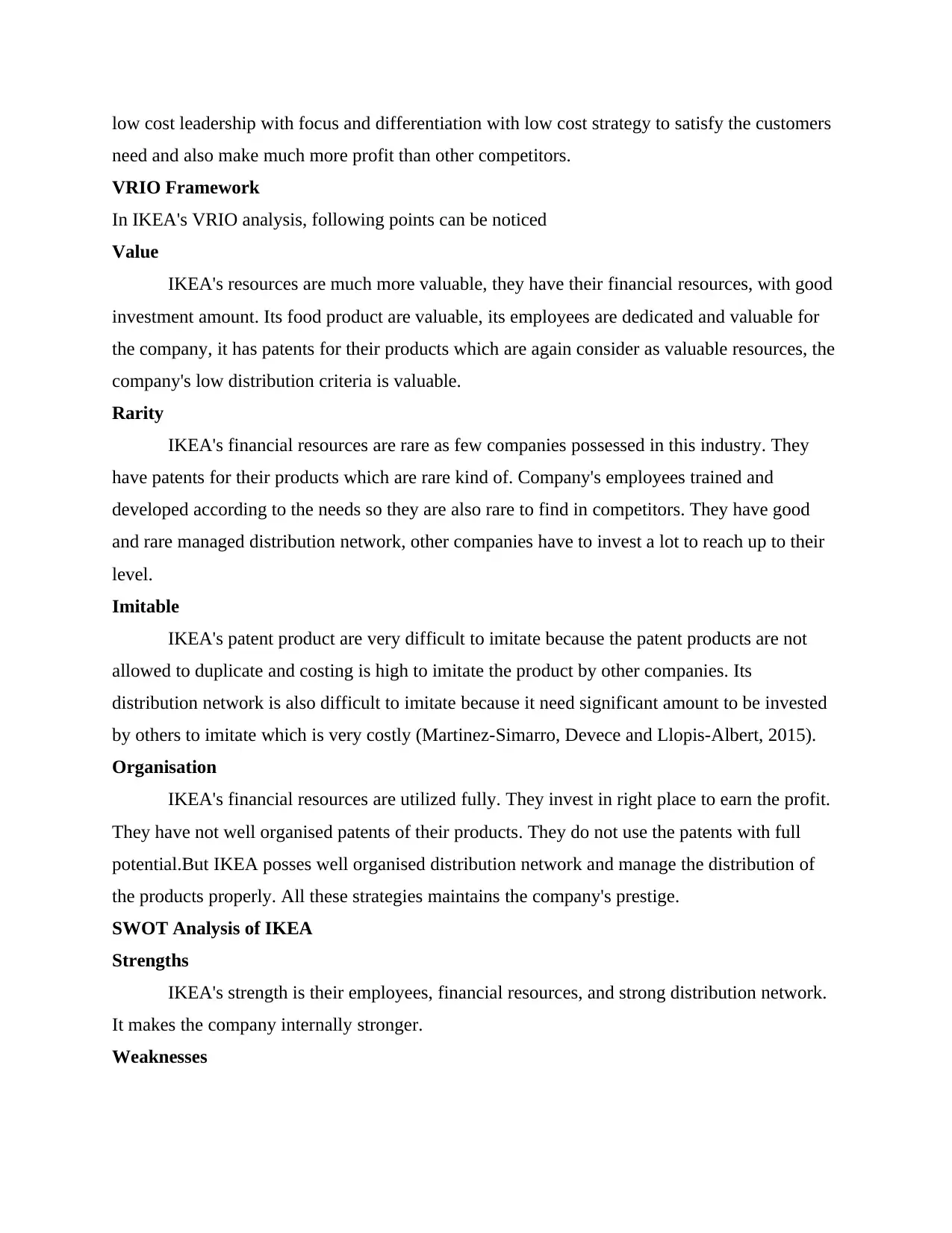
low cost leadership with focus and differentiation with low cost strategy to satisfy the customers
need and also make much more profit than other competitors.
VRIO Framework
In IKEA's VRIO analysis, following points can be noticed
Value
IKEA's resources are much more valuable, they have their financial resources, with good
investment amount. Its food product are valuable, its employees are dedicated and valuable for
the company, it has patents for their products which are again consider as valuable resources, the
company's low distribution criteria is valuable.
Rarity
IKEA's financial resources are rare as few companies possessed in this industry. They
have patents for their products which are rare kind of. Company's employees trained and
developed according to the needs so they are also rare to find in competitors. They have good
and rare managed distribution network, other companies have to invest a lot to reach up to their
level.
Imitable
IKEA's patent product are very difficult to imitate because the patent products are not
allowed to duplicate and costing is high to imitate the product by other companies. Its
distribution network is also difficult to imitate because it need significant amount to be invested
by others to imitate which is very costly (Martinez-Simarro, Devece and Llopis-Albert, 2015).
Organisation
IKEA's financial resources are utilized fully. They invest in right place to earn the profit.
They have not well organised patents of their products. They do not use the patents with full
potential.But IKEA posses well organised distribution network and manage the distribution of
the products properly. All these strategies maintains the company's prestige.
SWOT Analysis of IKEA
Strengths
IKEA's strength is their employees, financial resources, and strong distribution network.
It makes the company internally stronger.
Weaknesses
need and also make much more profit than other competitors.
VRIO Framework
In IKEA's VRIO analysis, following points can be noticed
Value
IKEA's resources are much more valuable, they have their financial resources, with good
investment amount. Its food product are valuable, its employees are dedicated and valuable for
the company, it has patents for their products which are again consider as valuable resources, the
company's low distribution criteria is valuable.
Rarity
IKEA's financial resources are rare as few companies possessed in this industry. They
have patents for their products which are rare kind of. Company's employees trained and
developed according to the needs so they are also rare to find in competitors. They have good
and rare managed distribution network, other companies have to invest a lot to reach up to their
level.
Imitable
IKEA's patent product are very difficult to imitate because the patent products are not
allowed to duplicate and costing is high to imitate the product by other companies. Its
distribution network is also difficult to imitate because it need significant amount to be invested
by others to imitate which is very costly (Martinez-Simarro, Devece and Llopis-Albert, 2015).
Organisation
IKEA's financial resources are utilized fully. They invest in right place to earn the profit.
They have not well organised patents of their products. They do not use the patents with full
potential.But IKEA posses well organised distribution network and manage the distribution of
the products properly. All these strategies maintains the company's prestige.
SWOT Analysis of IKEA
Strengths
IKEA's strength is their employees, financial resources, and strong distribution network.
It makes the company internally stronger.
Weaknesses
Paraphrase This Document
Need a fresh take? Get an instant paraphrase of this document with our AI Paraphraser
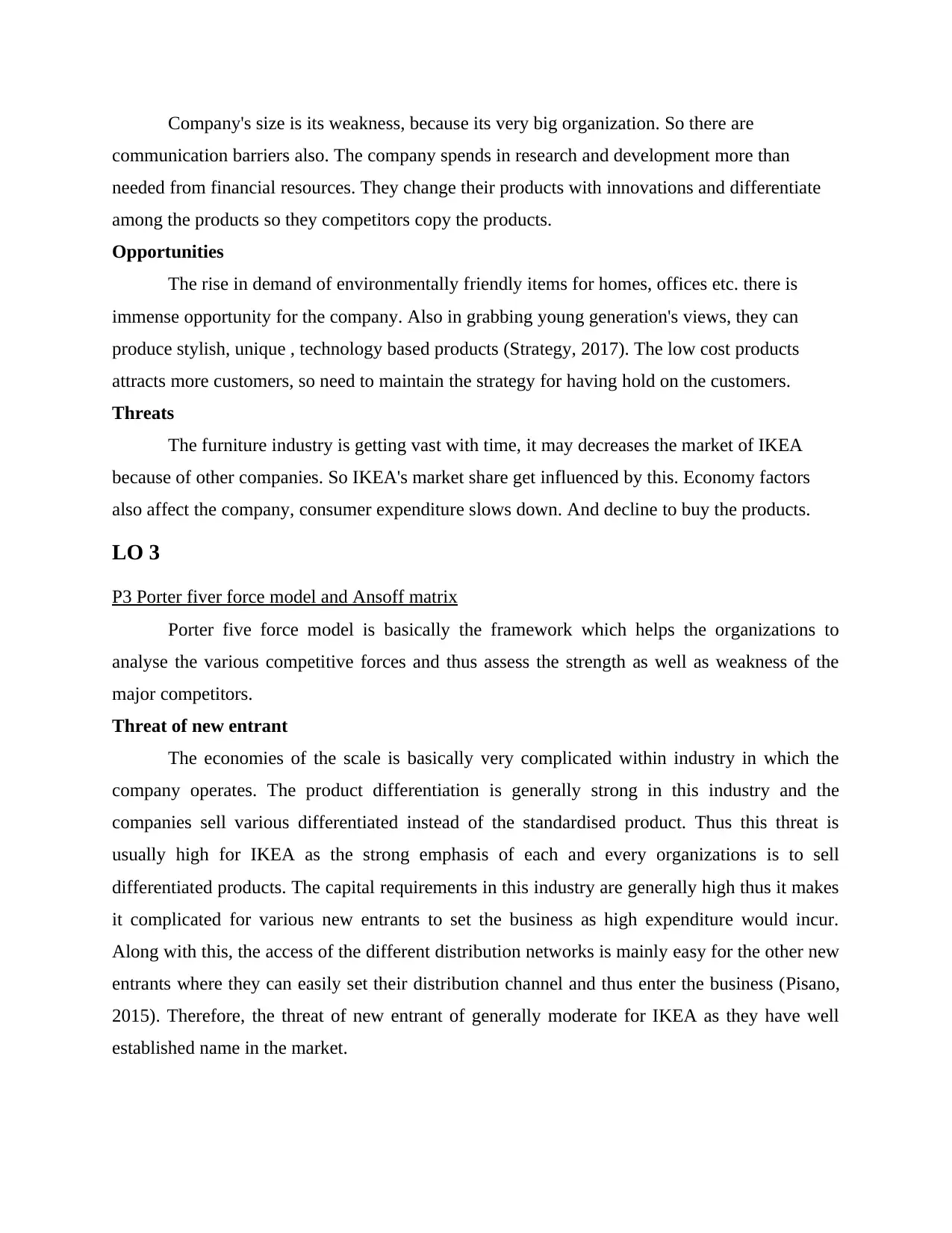
Company's size is its weakness, because its very big organization. So there are
communication barriers also. The company spends in research and development more than
needed from financial resources. They change their products with innovations and differentiate
among the products so they competitors copy the products.
Opportunities
The rise in demand of environmentally friendly items for homes, offices etc. there is
immense opportunity for the company. Also in grabbing young generation's views, they can
produce stylish, unique , technology based products (Strategy, 2017). The low cost products
attracts more customers, so need to maintain the strategy for having hold on the customers.
Threats
The furniture industry is getting vast with time, it may decreases the market of IKEA
because of other companies. So IKEA's market share get influenced by this. Economy factors
also affect the company, consumer expenditure slows down. And decline to buy the products.
LO 3
P3 Porter fiver force model and Ansoff matrix
Porter five force model is basically the framework which helps the organizations to
analyse the various competitive forces and thus assess the strength as well as weakness of the
major competitors.
Threat of new entrant
The economies of the scale is basically very complicated within industry in which the
company operates. The product differentiation is generally strong in this industry and the
companies sell various differentiated instead of the standardised product. Thus this threat is
usually high for IKEA as the strong emphasis of each and every organizations is to sell
differentiated products. The capital requirements in this industry are generally high thus it makes
it complicated for various new entrants to set the business as high expenditure would incur.
Along with this, the access of the different distribution networks is mainly easy for the other new
entrants where they can easily set their distribution channel and thus enter the business (Pisano,
2015). Therefore, the threat of new entrant of generally moderate for IKEA as they have well
established name in the market.
communication barriers also. The company spends in research and development more than
needed from financial resources. They change their products with innovations and differentiate
among the products so they competitors copy the products.
Opportunities
The rise in demand of environmentally friendly items for homes, offices etc. there is
immense opportunity for the company. Also in grabbing young generation's views, they can
produce stylish, unique , technology based products (Strategy, 2017). The low cost products
attracts more customers, so need to maintain the strategy for having hold on the customers.
Threats
The furniture industry is getting vast with time, it may decreases the market of IKEA
because of other companies. So IKEA's market share get influenced by this. Economy factors
also affect the company, consumer expenditure slows down. And decline to buy the products.
LO 3
P3 Porter fiver force model and Ansoff matrix
Porter five force model is basically the framework which helps the organizations to
analyse the various competitive forces and thus assess the strength as well as weakness of the
major competitors.
Threat of new entrant
The economies of the scale is basically very complicated within industry in which the
company operates. The product differentiation is generally strong in this industry and the
companies sell various differentiated instead of the standardised product. Thus this threat is
usually high for IKEA as the strong emphasis of each and every organizations is to sell
differentiated products. The capital requirements in this industry are generally high thus it makes
it complicated for various new entrants to set the business as high expenditure would incur.
Along with this, the access of the different distribution networks is mainly easy for the other new
entrants where they can easily set their distribution channel and thus enter the business (Pisano,
2015). Therefore, the threat of new entrant of generally moderate for IKEA as they have well
established name in the market.
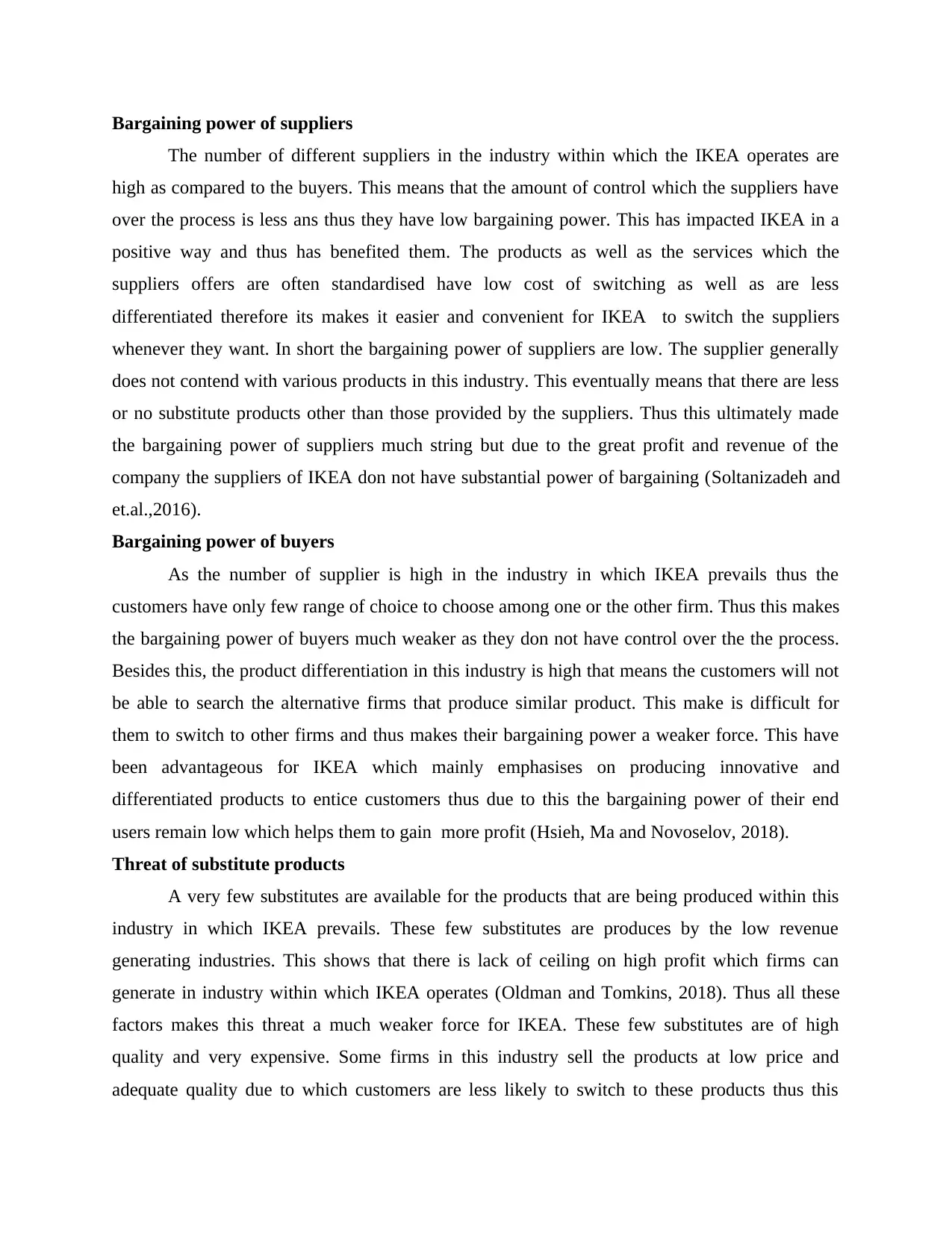
Bargaining power of suppliers
The number of different suppliers in the industry within which the IKEA operates are
high as compared to the buyers. This means that the amount of control which the suppliers have
over the process is less ans thus they have low bargaining power. This has impacted IKEA in a
positive way and thus has benefited them. The products as well as the services which the
suppliers offers are often standardised have low cost of switching as well as are less
differentiated therefore its makes it easier and convenient for IKEA to switch the suppliers
whenever they want. In short the bargaining power of suppliers are low. The supplier generally
does not contend with various products in this industry. This eventually means that there are less
or no substitute products other than those provided by the suppliers. Thus this ultimately made
the bargaining power of suppliers much string but due to the great profit and revenue of the
company the suppliers of IKEA don not have substantial power of bargaining (Soltanizadeh and
et.al.,2016).
Bargaining power of buyers
As the number of supplier is high in the industry in which IKEA prevails thus the
customers have only few range of choice to choose among one or the other firm. Thus this makes
the bargaining power of buyers much weaker as they don not have control over the the process.
Besides this, the product differentiation in this industry is high that means the customers will not
be able to search the alternative firms that produce similar product. This make is difficult for
them to switch to other firms and thus makes their bargaining power a weaker force. This have
been advantageous for IKEA which mainly emphasises on producing innovative and
differentiated products to entice customers thus due to this the bargaining power of their end
users remain low which helps them to gain more profit (Hsieh, Ma and Novoselov, 2018).
Threat of substitute products
A very few substitutes are available for the products that are being produced within this
industry in which IKEA prevails. These few substitutes are produces by the low revenue
generating industries. This shows that there is lack of ceiling on high profit which firms can
generate in industry within which IKEA operates (Oldman and Tomkins, 2018). Thus all these
factors makes this threat a much weaker force for IKEA. These few substitutes are of high
quality and very expensive. Some firms in this industry sell the products at low price and
adequate quality due to which customers are less likely to switch to these products thus this
The number of different suppliers in the industry within which the IKEA operates are
high as compared to the buyers. This means that the amount of control which the suppliers have
over the process is less ans thus they have low bargaining power. This has impacted IKEA in a
positive way and thus has benefited them. The products as well as the services which the
suppliers offers are often standardised have low cost of switching as well as are less
differentiated therefore its makes it easier and convenient for IKEA to switch the suppliers
whenever they want. In short the bargaining power of suppliers are low. The supplier generally
does not contend with various products in this industry. This eventually means that there are less
or no substitute products other than those provided by the suppliers. Thus this ultimately made
the bargaining power of suppliers much string but due to the great profit and revenue of the
company the suppliers of IKEA don not have substantial power of bargaining (Soltanizadeh and
et.al.,2016).
Bargaining power of buyers
As the number of supplier is high in the industry in which IKEA prevails thus the
customers have only few range of choice to choose among one or the other firm. Thus this makes
the bargaining power of buyers much weaker as they don not have control over the the process.
Besides this, the product differentiation in this industry is high that means the customers will not
be able to search the alternative firms that produce similar product. This make is difficult for
them to switch to other firms and thus makes their bargaining power a weaker force. This have
been advantageous for IKEA which mainly emphasises on producing innovative and
differentiated products to entice customers thus due to this the bargaining power of their end
users remain low which helps them to gain more profit (Hsieh, Ma and Novoselov, 2018).
Threat of substitute products
A very few substitutes are available for the products that are being produced within this
industry in which IKEA prevails. These few substitutes are produces by the low revenue
generating industries. This shows that there is lack of ceiling on high profit which firms can
generate in industry within which IKEA operates (Oldman and Tomkins, 2018). Thus all these
factors makes this threat a much weaker force for IKEA. These few substitutes are of high
quality and very expensive. Some firms in this industry sell the products at low price and
adequate quality due to which customers are less likely to switch to these products thus this
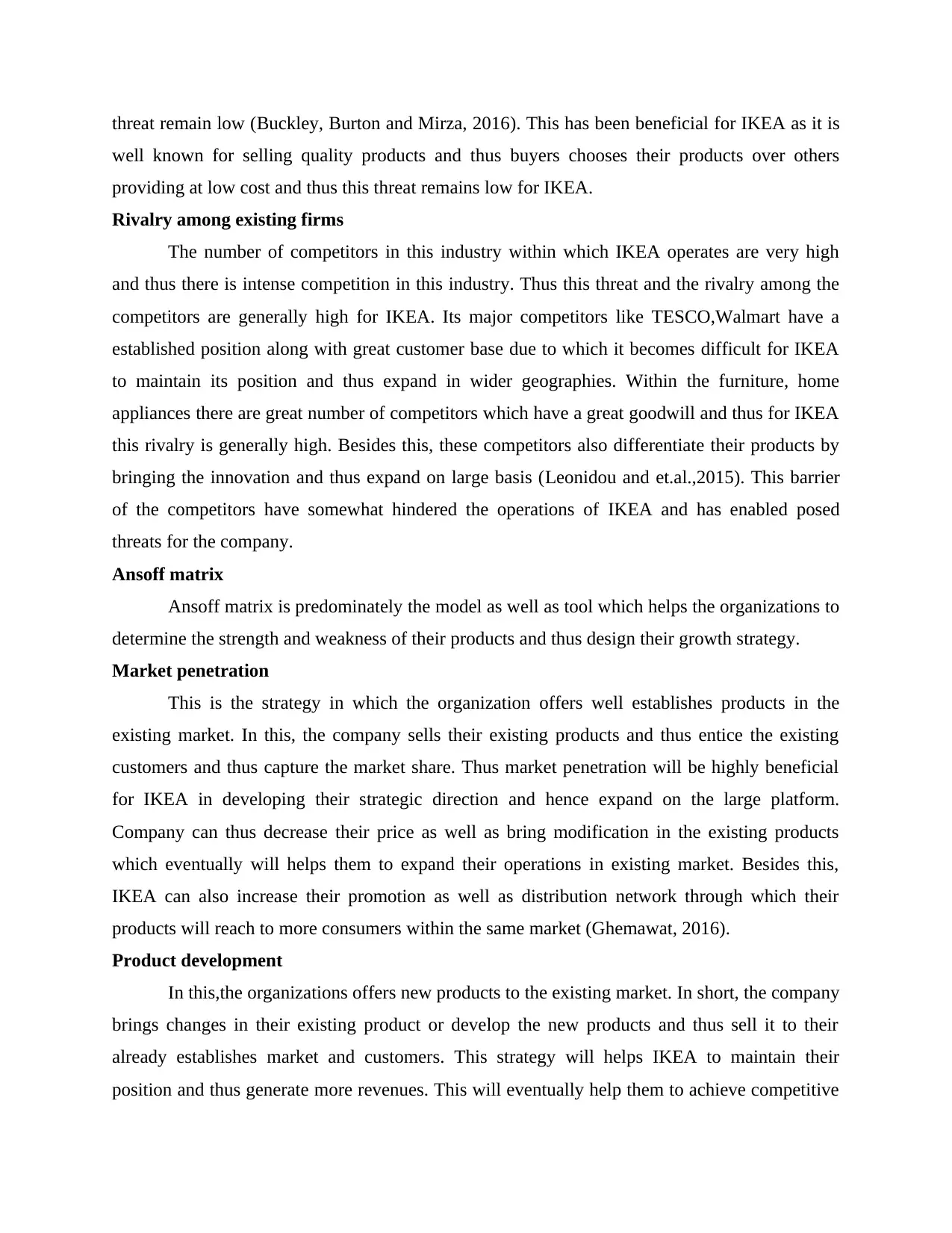
threat remain low (Buckley, Burton and Mirza, 2016). This has been beneficial for IKEA as it is
well known for selling quality products and thus buyers chooses their products over others
providing at low cost and thus this threat remains low for IKEA.
Rivalry among existing firms
The number of competitors in this industry within which IKEA operates are very high
and thus there is intense competition in this industry. Thus this threat and the rivalry among the
competitors are generally high for IKEA. Its major competitors like TESCO,Walmart have a
established position along with great customer base due to which it becomes difficult for IKEA
to maintain its position and thus expand in wider geographies. Within the furniture, home
appliances there are great number of competitors which have a great goodwill and thus for IKEA
this rivalry is generally high. Besides this, these competitors also differentiate their products by
bringing the innovation and thus expand on large basis (Leonidou and et.al.,2015). This barrier
of the competitors have somewhat hindered the operations of IKEA and has enabled posed
threats for the company.
Ansoff matrix
Ansoff matrix is predominately the model as well as tool which helps the organizations to
determine the strength and weakness of their products and thus design their growth strategy.
Market penetration
This is the strategy in which the organization offers well establishes products in the
existing market. In this, the company sells their existing products and thus entice the existing
customers and thus capture the market share. Thus market penetration will be highly beneficial
for IKEA in developing their strategic direction and hence expand on the large platform.
Company can thus decrease their price as well as bring modification in the existing products
which eventually will helps them to expand their operations in existing market. Besides this,
IKEA can also increase their promotion as well as distribution network through which their
products will reach to more consumers within the same market (Ghemawat, 2016).
Product development
In this,the organizations offers new products to the existing market. In short, the company
brings changes in their existing product or develop the new products and thus sell it to their
already establishes market and customers. This strategy will helps IKEA to maintain their
position and thus generate more revenues. This will eventually help them to achieve competitive
well known for selling quality products and thus buyers chooses their products over others
providing at low cost and thus this threat remains low for IKEA.
Rivalry among existing firms
The number of competitors in this industry within which IKEA operates are very high
and thus there is intense competition in this industry. Thus this threat and the rivalry among the
competitors are generally high for IKEA. Its major competitors like TESCO,Walmart have a
established position along with great customer base due to which it becomes difficult for IKEA
to maintain its position and thus expand in wider geographies. Within the furniture, home
appliances there are great number of competitors which have a great goodwill and thus for IKEA
this rivalry is generally high. Besides this, these competitors also differentiate their products by
bringing the innovation and thus expand on large basis (Leonidou and et.al.,2015). This barrier
of the competitors have somewhat hindered the operations of IKEA and has enabled posed
threats for the company.
Ansoff matrix
Ansoff matrix is predominately the model as well as tool which helps the organizations to
determine the strength and weakness of their products and thus design their growth strategy.
Market penetration
This is the strategy in which the organization offers well establishes products in the
existing market. In this, the company sells their existing products and thus entice the existing
customers and thus capture the market share. Thus market penetration will be highly beneficial
for IKEA in developing their strategic direction and hence expand on the large platform.
Company can thus decrease their price as well as bring modification in the existing products
which eventually will helps them to expand their operations in existing market. Besides this,
IKEA can also increase their promotion as well as distribution network through which their
products will reach to more consumers within the same market (Ghemawat, 2016).
Product development
In this,the organizations offers new products to the existing market. In short, the company
brings changes in their existing product or develop the new products and thus sell it to their
already establishes market and customers. This strategy will helps IKEA to maintain their
position and thus generate more revenues. This will eventually help them to achieve competitive
Secure Best Marks with AI Grader
Need help grading? Try our AI Grader for instant feedback on your assignments.
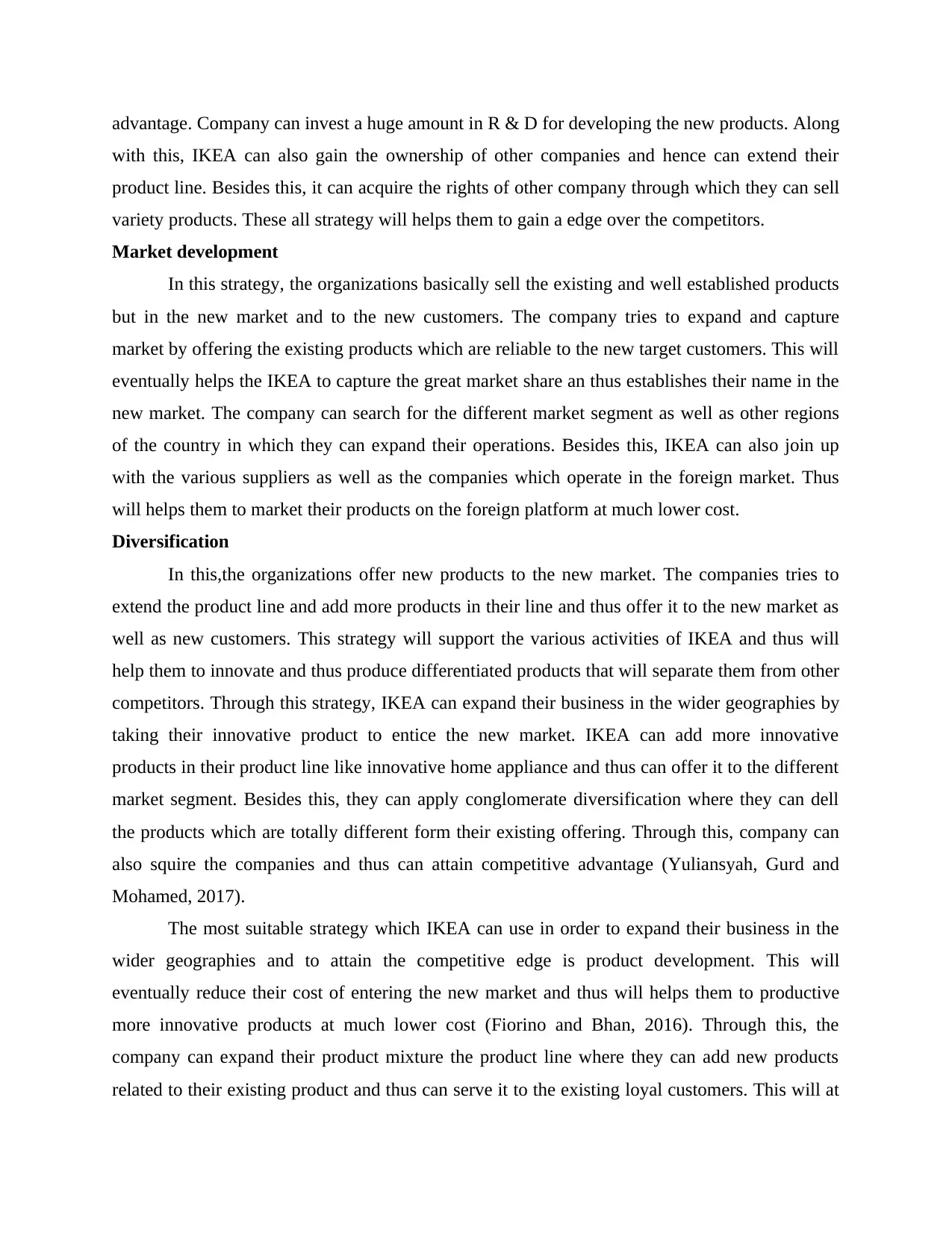
advantage. Company can invest a huge amount in R & D for developing the new products. Along
with this, IKEA can also gain the ownership of other companies and hence can extend their
product line. Besides this, it can acquire the rights of other company through which they can sell
variety products. These all strategy will helps them to gain a edge over the competitors.
Market development
In this strategy, the organizations basically sell the existing and well established products
but in the new market and to the new customers. The company tries to expand and capture
market by offering the existing products which are reliable to the new target customers. This will
eventually helps the IKEA to capture the great market share an thus establishes their name in the
new market. The company can search for the different market segment as well as other regions
of the country in which they can expand their operations. Besides this, IKEA can also join up
with the various suppliers as well as the companies which operate in the foreign market. Thus
will helps them to market their products on the foreign platform at much lower cost.
Diversification
In this,the organizations offer new products to the new market. The companies tries to
extend the product line and add more products in their line and thus offer it to the new market as
well as new customers. This strategy will support the various activities of IKEA and thus will
help them to innovate and thus produce differentiated products that will separate them from other
competitors. Through this strategy, IKEA can expand their business in the wider geographies by
taking their innovative product to entice the new market. IKEA can add more innovative
products in their product line like innovative home appliance and thus can offer it to the different
market segment. Besides this, they can apply conglomerate diversification where they can dell
the products which are totally different form their existing offering. Through this, company can
also squire the companies and thus can attain competitive advantage (Yuliansyah, Gurd and
Mohamed, 2017).
The most suitable strategy which IKEA can use in order to expand their business in the
wider geographies and to attain the competitive edge is product development. This will
eventually reduce their cost of entering the new market and thus will helps them to productive
more innovative products at much lower cost (Fiorino and Bhan, 2016). Through this, the
company can expand their product mixture the product line where they can add new products
related to their existing product and thus can serve it to the existing loyal customers. This will at
with this, IKEA can also gain the ownership of other companies and hence can extend their
product line. Besides this, it can acquire the rights of other company through which they can sell
variety products. These all strategy will helps them to gain a edge over the competitors.
Market development
In this strategy, the organizations basically sell the existing and well established products
but in the new market and to the new customers. The company tries to expand and capture
market by offering the existing products which are reliable to the new target customers. This will
eventually helps the IKEA to capture the great market share an thus establishes their name in the
new market. The company can search for the different market segment as well as other regions
of the country in which they can expand their operations. Besides this, IKEA can also join up
with the various suppliers as well as the companies which operate in the foreign market. Thus
will helps them to market their products on the foreign platform at much lower cost.
Diversification
In this,the organizations offer new products to the new market. The companies tries to
extend the product line and add more products in their line and thus offer it to the new market as
well as new customers. This strategy will support the various activities of IKEA and thus will
help them to innovate and thus produce differentiated products that will separate them from other
competitors. Through this strategy, IKEA can expand their business in the wider geographies by
taking their innovative product to entice the new market. IKEA can add more innovative
products in their product line like innovative home appliance and thus can offer it to the different
market segment. Besides this, they can apply conglomerate diversification where they can dell
the products which are totally different form their existing offering. Through this, company can
also squire the companies and thus can attain competitive advantage (Yuliansyah, Gurd and
Mohamed, 2017).
The most suitable strategy which IKEA can use in order to expand their business in the
wider geographies and to attain the competitive edge is product development. This will
eventually reduce their cost of entering the new market and thus will helps them to productive
more innovative products at much lower cost (Fiorino and Bhan, 2016). Through this, the
company can expand their product mixture the product line where they can add new products
related to their existing product and thus can serve it to the existing loyal customers. This will at
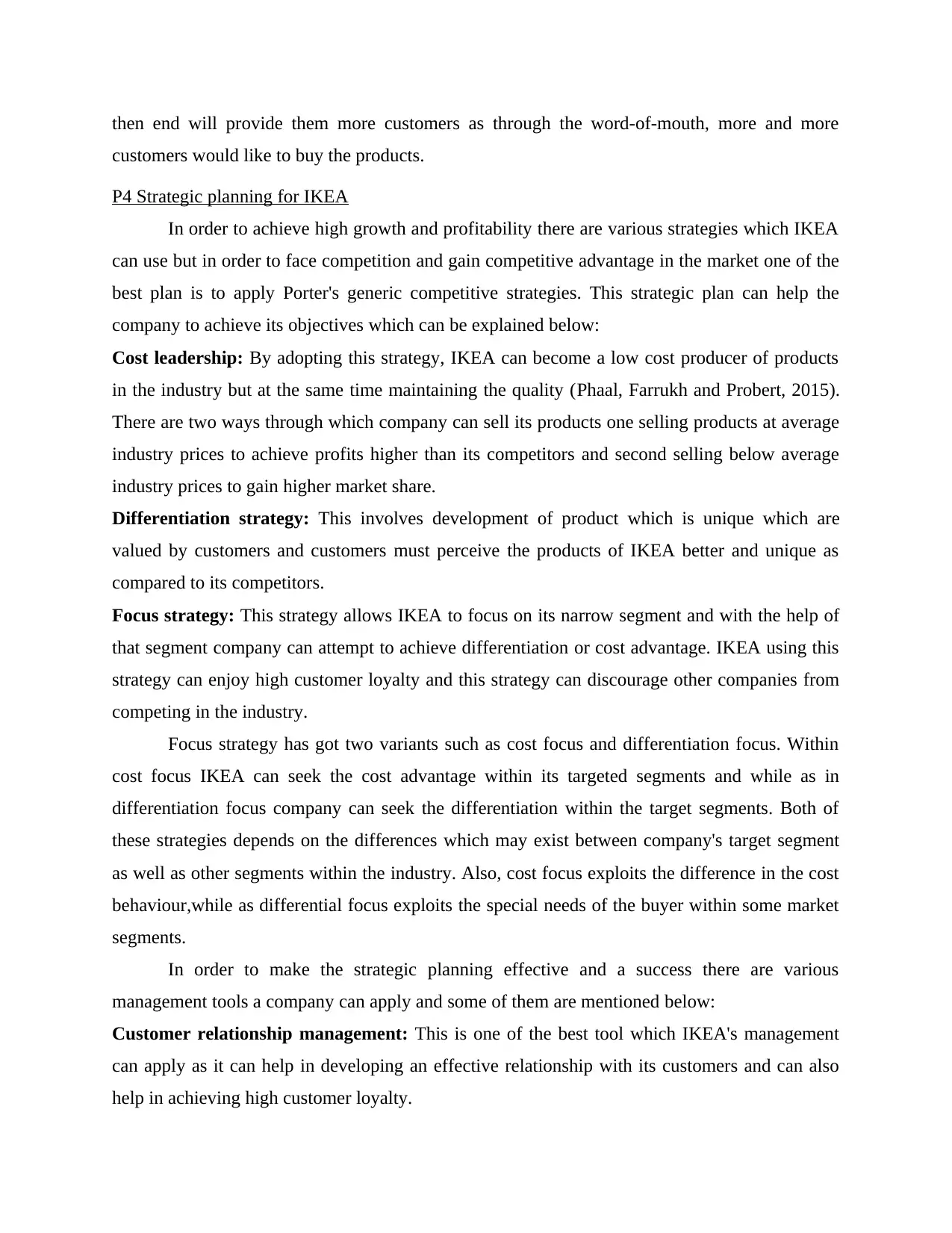
then end will provide them more customers as through the word-of-mouth, more and more
customers would like to buy the products.
P4 Strategic planning for IKEA
In order to achieve high growth and profitability there are various strategies which IKEA
can use but in order to face competition and gain competitive advantage in the market one of the
best plan is to apply Porter's generic competitive strategies. This strategic plan can help the
company to achieve its objectives which can be explained below:
Cost leadership: By adopting this strategy, IKEA can become a low cost producer of products
in the industry but at the same time maintaining the quality (Phaal, Farrukh and Probert, 2015).
There are two ways through which company can sell its products one selling products at average
industry prices to achieve profits higher than its competitors and second selling below average
industry prices to gain higher market share.
Differentiation strategy: This involves development of product which is unique which are
valued by customers and customers must perceive the products of IKEA better and unique as
compared to its competitors.
Focus strategy: This strategy allows IKEA to focus on its narrow segment and with the help of
that segment company can attempt to achieve differentiation or cost advantage. IKEA using this
strategy can enjoy high customer loyalty and this strategy can discourage other companies from
competing in the industry.
Focus strategy has got two variants such as cost focus and differentiation focus. Within
cost focus IKEA can seek the cost advantage within its targeted segments and while as in
differentiation focus company can seek the differentiation within the target segments. Both of
these strategies depends on the differences which may exist between company's target segment
as well as other segments within the industry. Also, cost focus exploits the difference in the cost
behaviour,while as differential focus exploits the special needs of the buyer within some market
segments.
In order to make the strategic planning effective and a success there are various
management tools a company can apply and some of them are mentioned below:
Customer relationship management: This is one of the best tool which IKEA's management
can apply as it can help in developing an effective relationship with its customers and can also
help in achieving high customer loyalty.
customers would like to buy the products.
P4 Strategic planning for IKEA
In order to achieve high growth and profitability there are various strategies which IKEA
can use but in order to face competition and gain competitive advantage in the market one of the
best plan is to apply Porter's generic competitive strategies. This strategic plan can help the
company to achieve its objectives which can be explained below:
Cost leadership: By adopting this strategy, IKEA can become a low cost producer of products
in the industry but at the same time maintaining the quality (Phaal, Farrukh and Probert, 2015).
There are two ways through which company can sell its products one selling products at average
industry prices to achieve profits higher than its competitors and second selling below average
industry prices to gain higher market share.
Differentiation strategy: This involves development of product which is unique which are
valued by customers and customers must perceive the products of IKEA better and unique as
compared to its competitors.
Focus strategy: This strategy allows IKEA to focus on its narrow segment and with the help of
that segment company can attempt to achieve differentiation or cost advantage. IKEA using this
strategy can enjoy high customer loyalty and this strategy can discourage other companies from
competing in the industry.
Focus strategy has got two variants such as cost focus and differentiation focus. Within
cost focus IKEA can seek the cost advantage within its targeted segments and while as in
differentiation focus company can seek the differentiation within the target segments. Both of
these strategies depends on the differences which may exist between company's target segment
as well as other segments within the industry. Also, cost focus exploits the difference in the cost
behaviour,while as differential focus exploits the special needs of the buyer within some market
segments.
In order to make the strategic planning effective and a success there are various
management tools a company can apply and some of them are mentioned below:
Customer relationship management: This is one of the best tool which IKEA's management
can apply as it can help in developing an effective relationship with its customers and can also
help in achieving high customer loyalty.
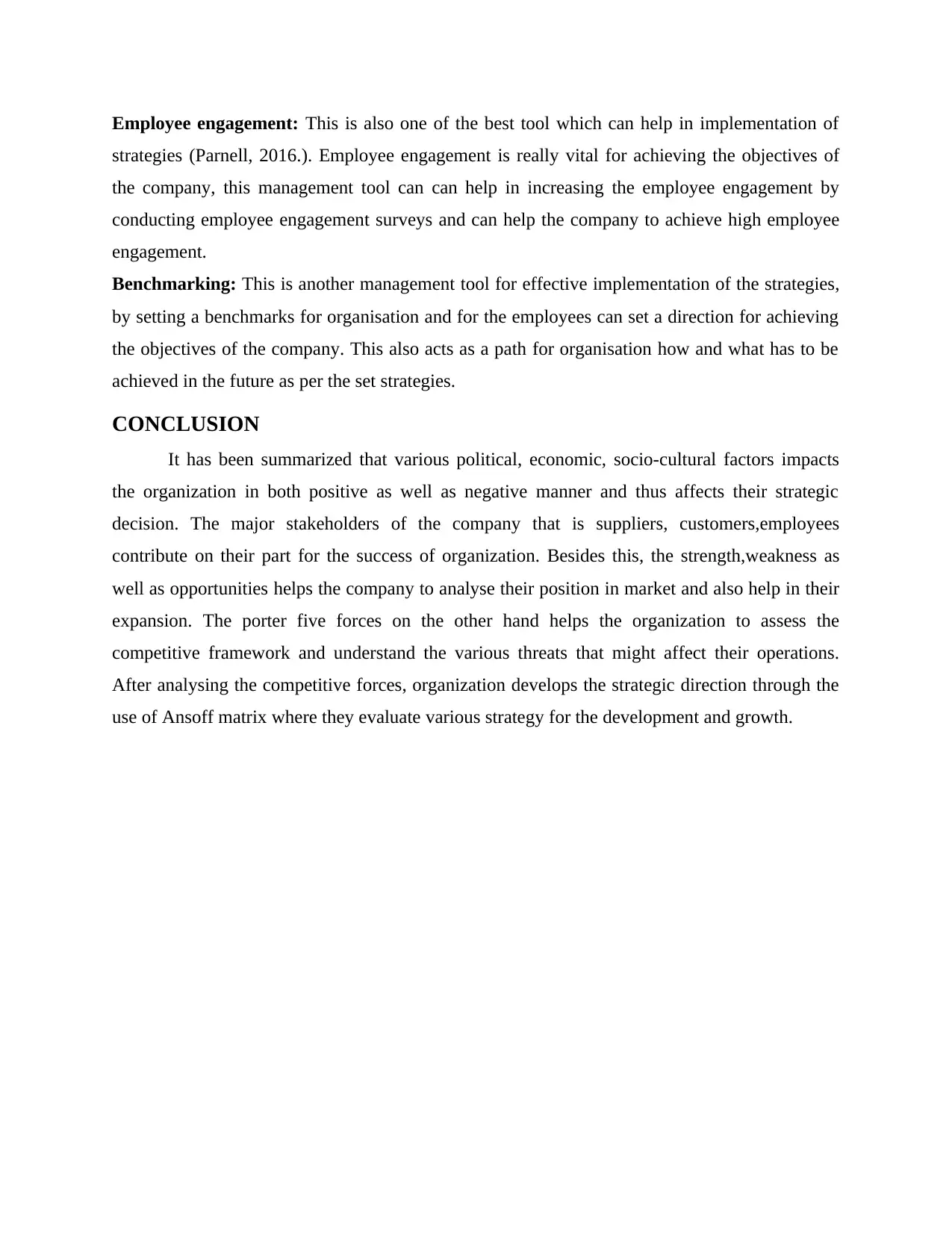
Employee engagement: This is also one of the best tool which can help in implementation of
strategies (Parnell, 2016.). Employee engagement is really vital for achieving the objectives of
the company, this management tool can can help in increasing the employee engagement by
conducting employee engagement surveys and can help the company to achieve high employee
engagement.
Benchmarking: This is another management tool for effective implementation of the strategies,
by setting a benchmarks for organisation and for the employees can set a direction for achieving
the objectives of the company. This also acts as a path for organisation how and what has to be
achieved in the future as per the set strategies.
CONCLUSION
It has been summarized that various political, economic, socio-cultural factors impacts
the organization in both positive as well as negative manner and thus affects their strategic
decision. The major stakeholders of the company that is suppliers, customers,employees
contribute on their part for the success of organization. Besides this, the strength,weakness as
well as opportunities helps the company to analyse their position in market and also help in their
expansion. The porter five forces on the other hand helps the organization to assess the
competitive framework and understand the various threats that might affect their operations.
After analysing the competitive forces, organization develops the strategic direction through the
use of Ansoff matrix where they evaluate various strategy for the development and growth.
strategies (Parnell, 2016.). Employee engagement is really vital for achieving the objectives of
the company, this management tool can can help in increasing the employee engagement by
conducting employee engagement surveys and can help the company to achieve high employee
engagement.
Benchmarking: This is another management tool for effective implementation of the strategies,
by setting a benchmarks for organisation and for the employees can set a direction for achieving
the objectives of the company. This also acts as a path for organisation how and what has to be
achieved in the future as per the set strategies.
CONCLUSION
It has been summarized that various political, economic, socio-cultural factors impacts
the organization in both positive as well as negative manner and thus affects their strategic
decision. The major stakeholders of the company that is suppliers, customers,employees
contribute on their part for the success of organization. Besides this, the strength,weakness as
well as opportunities helps the company to analyse their position in market and also help in their
expansion. The porter five forces on the other hand helps the organization to assess the
competitive framework and understand the various threats that might affect their operations.
After analysing the competitive forces, organization develops the strategic direction through the
use of Ansoff matrix where they evaluate various strategy for the development and growth.
Paraphrase This Document
Need a fresh take? Get an instant paraphrase of this document with our AI Paraphraser
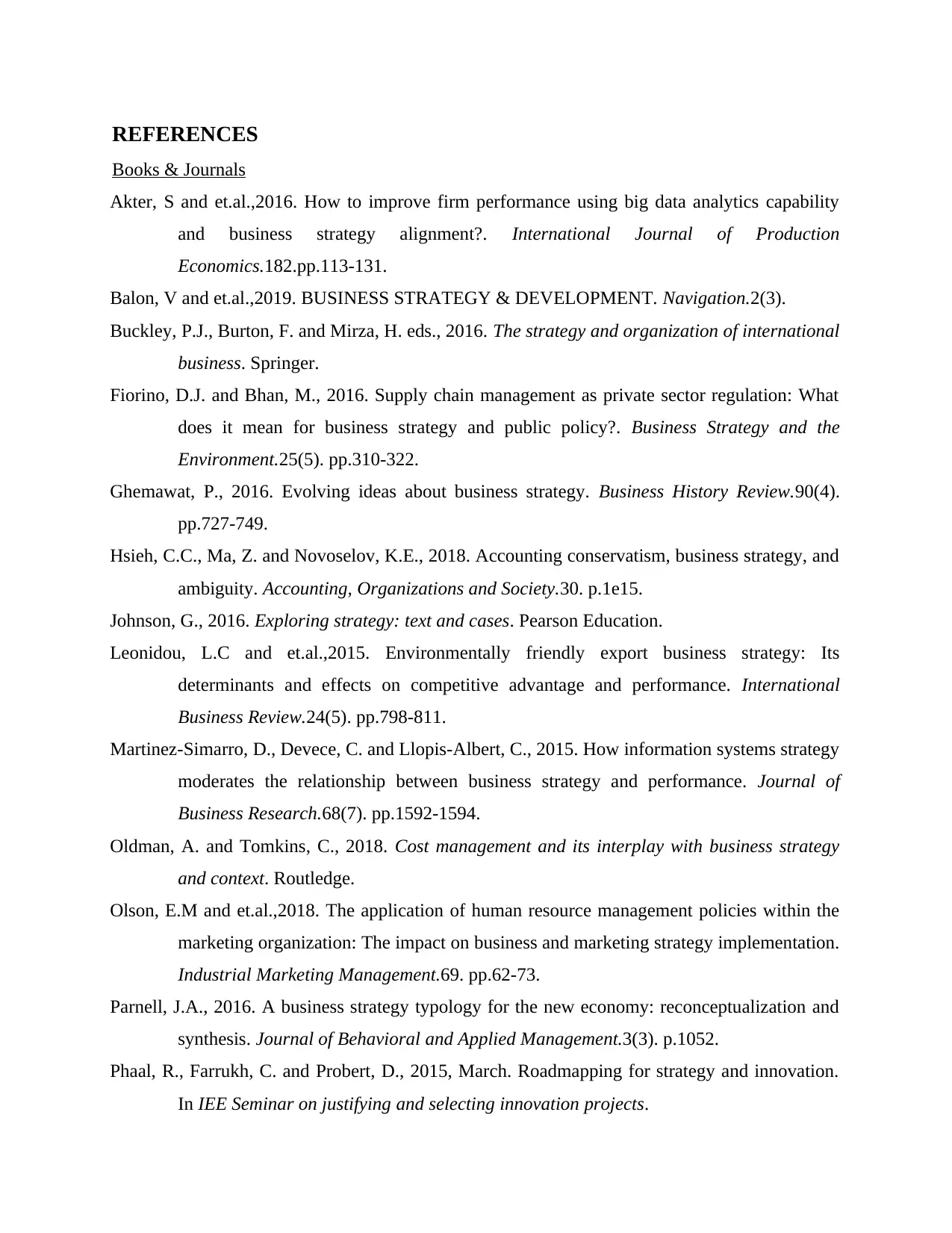
REFERENCES
Books & Journals
Akter, S and et.al.,2016. How to improve firm performance using big data analytics capability
and business strategy alignment?. International Journal of Production
Economics.182.pp.113-131.
Balon, V and et.al.,2019. BUSINESS STRATEGY & DEVELOPMENT. Navigation.2(3).
Buckley, P.J., Burton, F. and Mirza, H. eds., 2016. The strategy and organization of international
business. Springer.
Fiorino, D.J. and Bhan, M., 2016. Supply chain management as private sector regulation: What
does it mean for business strategy and public policy?. Business Strategy and the
Environment.25(5). pp.310-322.
Ghemawat, P., 2016. Evolving ideas about business strategy. Business History Review.90(4).
pp.727-749.
Hsieh, C.C., Ma, Z. and Novoselov, K.E., 2018. Accounting conservatism, business strategy, and
ambiguity. Accounting, Organizations and Society.30. p.1e15.
Johnson, G., 2016. Exploring strategy: text and cases. Pearson Education.
Leonidou, L.C and et.al.,2015. Environmentally friendly export business strategy: Its
determinants and effects on competitive advantage and performance. International
Business Review.24(5). pp.798-811.
Martinez-Simarro, D., Devece, C. and Llopis-Albert, C., 2015. How information systems strategy
moderates the relationship between business strategy and performance. Journal of
Business Research.68(7). pp.1592-1594.
Oldman, A. and Tomkins, C., 2018. Cost management and its interplay with business strategy
and context. Routledge.
Olson, E.M and et.al.,2018. The application of human resource management policies within the
marketing organization: The impact on business and marketing strategy implementation.
Industrial Marketing Management.69. pp.62-73.
Parnell, J.A., 2016. A business strategy typology for the new economy: reconceptualization and
synthesis. Journal of Behavioral and Applied Management.3(3). p.1052.
Phaal, R., Farrukh, C. and Probert, D., 2015, March. Roadmapping for strategy and innovation.
In IEE Seminar on justifying and selecting innovation projects.
Books & Journals
Akter, S and et.al.,2016. How to improve firm performance using big data analytics capability
and business strategy alignment?. International Journal of Production
Economics.182.pp.113-131.
Balon, V and et.al.,2019. BUSINESS STRATEGY & DEVELOPMENT. Navigation.2(3).
Buckley, P.J., Burton, F. and Mirza, H. eds., 2016. The strategy and organization of international
business. Springer.
Fiorino, D.J. and Bhan, M., 2016. Supply chain management as private sector regulation: What
does it mean for business strategy and public policy?. Business Strategy and the
Environment.25(5). pp.310-322.
Ghemawat, P., 2016. Evolving ideas about business strategy. Business History Review.90(4).
pp.727-749.
Hsieh, C.C., Ma, Z. and Novoselov, K.E., 2018. Accounting conservatism, business strategy, and
ambiguity. Accounting, Organizations and Society.30. p.1e15.
Johnson, G., 2016. Exploring strategy: text and cases. Pearson Education.
Leonidou, L.C and et.al.,2015. Environmentally friendly export business strategy: Its
determinants and effects on competitive advantage and performance. International
Business Review.24(5). pp.798-811.
Martinez-Simarro, D., Devece, C. and Llopis-Albert, C., 2015. How information systems strategy
moderates the relationship between business strategy and performance. Journal of
Business Research.68(7). pp.1592-1594.
Oldman, A. and Tomkins, C., 2018. Cost management and its interplay with business strategy
and context. Routledge.
Olson, E.M and et.al.,2018. The application of human resource management policies within the
marketing organization: The impact on business and marketing strategy implementation.
Industrial Marketing Management.69. pp.62-73.
Parnell, J.A., 2016. A business strategy typology for the new economy: reconceptualization and
synthesis. Journal of Behavioral and Applied Management.3(3). p.1052.
Phaal, R., Farrukh, C. and Probert, D., 2015, March. Roadmapping for strategy and innovation.
In IEE Seminar on justifying and selecting innovation projects.
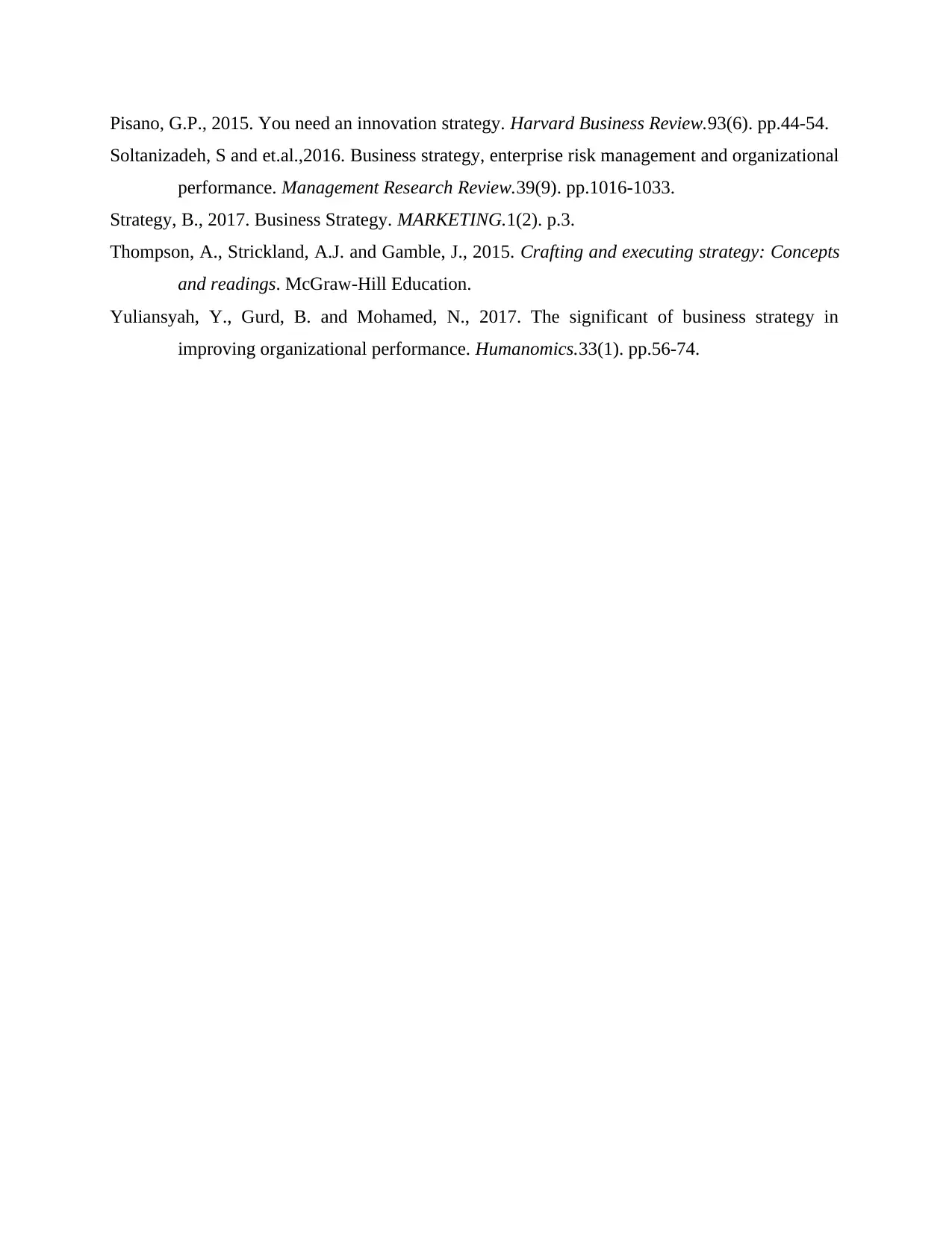
Pisano, G.P., 2015. You need an innovation strategy. Harvard Business Review.93(6). pp.44-54.
Soltanizadeh, S and et.al.,2016. Business strategy, enterprise risk management and organizational
performance. Management Research Review.39(9). pp.1016-1033.
Strategy, B., 2017. Business Strategy. MARKETING.1(2). p.3.
Thompson, A., Strickland, A.J. and Gamble, J., 2015. Crafting and executing strategy: Concepts
and readings. McGraw-Hill Education.
Yuliansyah, Y., Gurd, B. and Mohamed, N., 2017. The significant of business strategy in
improving organizational performance. Humanomics.33(1). pp.56-74.
Soltanizadeh, S and et.al.,2016. Business strategy, enterprise risk management and organizational
performance. Management Research Review.39(9). pp.1016-1033.
Strategy, B., 2017. Business Strategy. MARKETING.1(2). p.3.
Thompson, A., Strickland, A.J. and Gamble, J., 2015. Crafting and executing strategy: Concepts
and readings. McGraw-Hill Education.
Yuliansyah, Y., Gurd, B. and Mohamed, N., 2017. The significant of business strategy in
improving organizational performance. Humanomics.33(1). pp.56-74.
1 out of 15
Related Documents
Your All-in-One AI-Powered Toolkit for Academic Success.
+13062052269
info@desklib.com
Available 24*7 on WhatsApp / Email
![[object Object]](/_next/static/media/star-bottom.7253800d.svg)
Unlock your academic potential
© 2024 | Zucol Services PVT LTD | All rights reserved.




